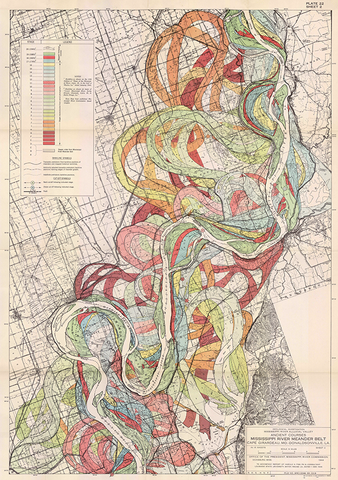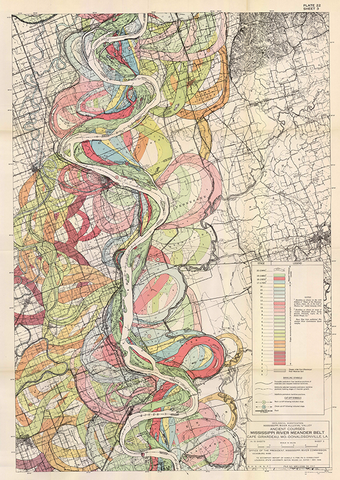We continue to be mesmerized by the Mississippi River. Our editions today—Plate 22, Sheet 2, Ancient Courses Mississippi River Meander Belt and Plate 22, Sheet 3, Ancient Courses Mississippi River Meander Belt—visualize the path of the river many eons ago and give us the chance to imagine its future.


Plate 22, Sheet 2, Ancient Courses Mississippi River Meander Belt, a 20x200 Vintage Edition
10"x7" ($24) | 14"x10" ($60) | 20"x14" ($240) | 30"x21" ($600) | 40"x28" ($1800)
Plate 22, Sheet 3, Ancient Courses Mississippi River Meander Belt, a 20x200 Vintage Edition
10"x7" ($24) | 14"x10" ($60) | 20"x14" ($240) | 30"x21" ($600) | 40"x28" ($1800)
People say looking at the stars can leave them feeling insignificant. The same effect can be felt standing on the banks of the Mississippi, one of the most powerful rivers in the world. While stars have little affect on us here on Earth other than making us question our philosophical purpose, Plate 22, Sheet 2, Ancient Courses Mississippi River Meander Belt and Plate 22, Sheet 3, Ancient Courses Mississippi River Meander Belt remind us of the Mississippi’s raw, untameable energy.
One might mistake these maps for abstract art filled with graceful loops and swirls. However, these autumnal ribbons represent geological data: shifts in the river’s course, color-categorized by periods of time dating from prehistory to the 20th century. Created in 1944 by cartographer Harold Fisk, this series of maps track the ways the Mississippi’s path has changed and shifted the landscape surrounding it.
And as the landscape has changed, so have our purposes for the river. Native nomadic tribes herded along the riverside, keeping close to their source of food and water. Other tribes began to settle in the fertile areas of the river valley, perfect for agriculture. As more and more people settled, cities grew, and the river became a route of travel and trade. It is mesmerizing to look at the swirls of color on Plate 22, Sheet 2, Ancient Courses Mississippi River Meander Belt and Plate 22, Sheet 3, Ancient Courses Mississippi River Meander Belt and imagine the subcultures gathered at each bend and twist. Were they hunting along its banks? Were they building homes, caring for fields, or just stepping off the steamboat to visit, trade, and tell their stories?
Perhaps the more important question is: what will the culture of the river become? The river has been running for eons and will more than likely continue for eons to come, creating new and numerous channels. We can’t see what the future holds, but Plate 22, Sheet 2, Ancient Courses Mississippi River Meander Belt and Plate 22, Sheet 3, Ancient Courses Mississippi River Meander Belt certainly inspire us to dream.
With art for everyone,
Team 20x200











